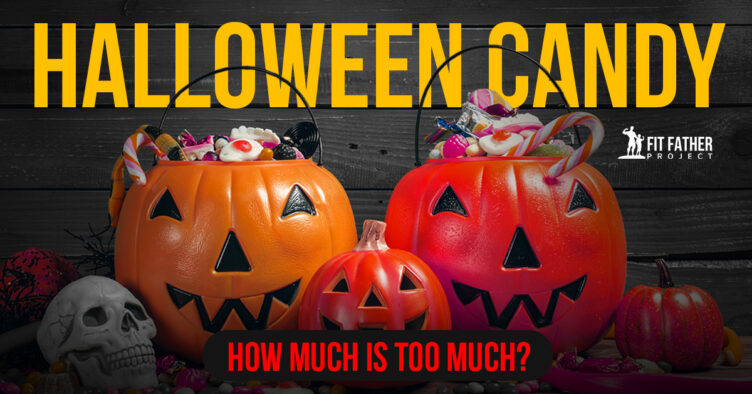Do you dread having Halloween candy in your home for fear of eating too much of it, gaining weight, and feeling guilty?
How much Halloween candy is too much?
Some of the best ways to feel great and avoid feeling guilty this Halloween is to continue on with your healthy living program as best you can.
This means planning healthy menus, keeping your body active throughout the day, drinking plenty of water, doing planned exercise, and sleeping at least 7 hours per night.
Recruit your entire family to join you in a healthy journey this Halloween. Begin the journey by setting goals regarding your intake of Halloween candy.
Do what you can to steer clear of candy and other sweet treats, but if you choose to eat these foods containing added sugar, do so in moderation. If you struggle with limiting your Halloween candy intake, avoid keeping it in your home before and after the holiday.
Keep reading to find out how to avoid and overcome all those Halloween temptations!
Learn more about those dreaded Halloween candy binges and what to do with all that candy!
The Nutrient Content of Halloween Candy
Calories and added sugar in candy and other Halloween treats can add up quickly, and much of the content of sweet treats is carbohydrates from added sugar.
Most Halloween candy contains little to no fiber or protein, which means it doesn't keep you full very long. The following list contains popular candies and bars, along with their corresponding calorie and total sugar content:
- Original M&M's: 230 calories and 31 grams of sugar
- Peanut Butter M&M's: 240 calories and 22 grams of sugar
- Snickers: 250 calories and 28 grams of sugar
- Reese's Peanut Butter Cups: 210 calories and 21 grams of sugar
- Hershey Bar: 220 calories and 25 grams of sugar
- Skittles: 250 calories and 46 grams of sugar
- Giant Tootsie Roll: 250 calories and 35 grams of sugar
- Butterfinger: 250 calories and 21 grams of sugar
- 8 pieces of Starburst: 160 calories and 22 grams of sugar
While fun-sized Halloween treats contain fewer calories and less sugar than a regular-sized portion, you may find yourself eating multiple fun-sized packages while splurging on Halloween candy.
How Much Halloween Candy is Too Much?
Being around Halloween candy is often inevitable if you have children who enjoy trick-or-treating. So, is it OK to have just SOME Halloween candy this holiday season?
The truth is that it's better to forgo Halloween candy altogether in favor of healthy Halloween treats instead.
If having Halloween candy is something you really enjoy, there's nothing wrong with eating it in moderation from time to time. The problem for some people is that having just a little bit of Halloween candy leads to cravings for more candy and even sugar addictions.
The same holds true for kids, as eating too much candy can become an addictive habit.
Eating (or not eating) Halloween candy is entirely up to you, but consider consuming healthy Halloween treats instead of traditional candy this season!
How Many Discretionary Calories Should I Allow?
The United States Department of Agriculture (USDA) Dietary Guidelines for Americans offers guidelines for eating empty calories from sweets or other junk foods. This discretionary calorie allotment depends on your total daily energy needs based on age, gender, and activity level.
Using these USDA guidelines, you have the following discretionary calories to use as you see fit:
- 2,000-calorie meal plan: 240 calories
- 2,200-calorie meal plan: 250 calories
- 2,400-calorie meal plan: 320 calories
- 2,600-calorie meal plan: 350 calories
- 2,800-calorie meal plan: 370 calories
- 3,000-calorie meal plan: 440 calories
While you can use discretionary calories to consume Halloween candy if you want to, less is better when it comes to empty calories and sweet treats!
I Love Halloween Candy: Can I Be Healthy and Still Eat It?
The answer is yes; you can maintain outstanding health by including some Halloween candy in your meal plan, as long as you do so in moderation.
Don't feel like you have to give up candy entirely. However, some things to consider after eating candy include going for a walk, brushing your teeth, or chewing gum — and setting goals for yourself and your family so you don't overindulge.
If you can't pass up the Halloween candy entirely this season, consider sugar-free candy or other healthier options! Choose candies sweetened with stevia, erythritol, or monk fruit instead of sugar or artificial sweeteners.
You might pick chocolate-covered treats that contain nuts or nut butter as ingredients. Pick dark chocolate over traditional milk chocolate to reduce added sugar and reap the health benefits associated with antioxidants.
But if you can, steer clear of candy altogether in favor of healthier options, as this is the ideal option.
However, if you're like many parents of younger kids, you'd prefer to keep the tradition of going trick-or-treating. This fun Halloween tradition almost surely means you'll receive candy or other junk foods.
If you're wondering what to do with leftover Halloween candy, donating it is always a good choice. And don't feel guilty about throwing away leftover candy and other sweets to avoid keeping them in your house, as the memories you'll make earning the candy are most important.
Here’s A Free Weight Loss Meal Plan For Busy Men 40+
Discover exactly what to eat for breakfast, lunch, and dinner to lose belly fat & feel energized 24/7 without hard dieting...
How To Have a Healthier Halloween
You and your family can choose from numerous healthy Halloween snacks when you want to avoid candy and other sweet treats.
In addition to choosing sugar-free candy, you might opt for:
- Nuts

- Seeds
- Tangerines
- Grapes
- Other fresh fruits
- Dried fruit without added sugar
- Dark chocolate
- Protein bars low in sugar
- Nutritious protein shakes
- Popsicles made of whole-food ingredients
- Applesauce without added sugar
- Cheese sticks
- Dark chocolate-covered fruits or nuts
- Sliced apples, bananas, or pears topped with nut butter
Another way to avoid Halloween candy is to choose non-edible items to fill Halloween bags with instead of sweet treats. For example, you might offer neighborhood kids (or your own kids or grandkids) fun toys that will keep them entertained. By offering toys instead of sweets, kids won't think twice about having less candy this Halloween.
Ways to Avoid Weight Gain from Halloween Candy
Several strategies can help you eat less candy this Halloween season and avoid Halloween weight gain:
- Donate or throw away extra Halloween candy
- Avoid keeping candy in your home
- Drink a glass of water before eating candy
- Eat a nutritious meal (containing vegetables and protein) before the candy
- Choose fresh or dried fruit (without added sugar) in place of candy
- Replace candy with healthy Halloween treats (link to article)
- Go for a walk or work out after eating candy
- Set goals
- Write down your candy intake in a food journal
- Weigh yourself daily
Adopting these or other helpful habits, you can stay healthy and avoid dreaded weight gain and chronic disease risk factors associated with excess body weight.
Don't be too hard on yourself if you accidentally splurge on Halloween candy, as many people encounter candy overload from time to time. Even the healthiest eaters often allow themselves a cheat day every now and then, so if you have a moment of weakness this Halloween, just count it as your cheat day!
After accidentally overindulging in candy, let it digest, go for a walk, and drink plenty of water. Simply get back on track with your healthy eating plan the following day after a full night's rest.
Remove candy from easily accessible areas of your home, donate it, or throw it away. Start fresh the next day by drinking at least two glasses of water when you wake up.
Eat three nutritious meals filled with vegetables and other sources of fiber, protein, and heart-healthy fats. Consume nutritious snacks as needed throughout the day.
Make sure you make time for exercise. You might bump up your cardio the day after a Halloween cheat day to expend extra calories and detox during sweat sessions. Be active with your kids regularly, including on and after Halloween.
Here’s a FREE Meal Plan & Workout For Busy Men 40+
We’ll show you exactly what to eat & how to exercise to reignite your metabolism in your 40’s, 50’s & 60’s.
Erin Coleman is a registered and licensed dietitian with over 15 years of freelance writing experience. She graduated with her Bachelor of Science degree in nutritional science from the University of Wisconsin-Madison, and completed her dietetic internship at Viterbo University in La Crosse, Wisconsin. Prior to beginning her career in medical content writing, Erin worked as Health Educator for the University of Wisconsin-Madison Department of Internal Medicine. Her published work appears on hundreds of health and fitness websites, and she’s currently working on publishing her first book! Erin is a wife, and a Mom to two beautiful children.Erin Coleman, B.S. Nutritional Science, R.D., L.D.
Writer, Fit Father Project
The FOUNDATIONS Program is created by Dr. Anthony Balduzzi for Men 40+ who want Lifelong Health. In just 6-Weeks following FOUNDATIONS, you'll experience: FOUNDATIONS has transformed 60,000 lives! Are you ready to experience true lasting health & results?Join our 6-Week Doctor Designed Health Program. You'll Gain Foundational Health for the Rest of Life.
*Please know that weight loss results and health changes/improvements vary from individual to individual; you may not achieve similar results. Always consult with your doctor before making health decisions. This is not medical advice – simply very well-researched info on Halloween candy.





